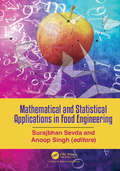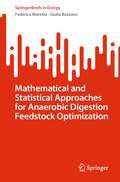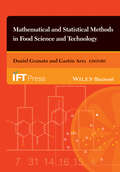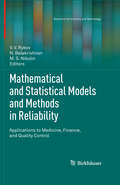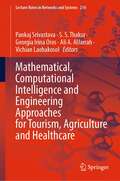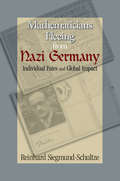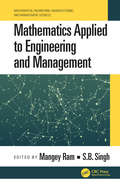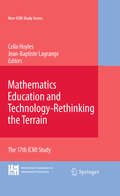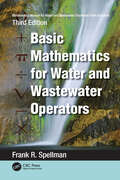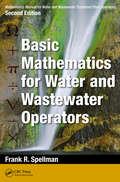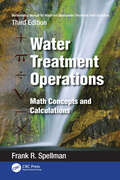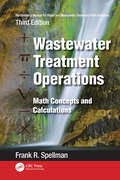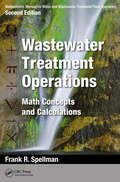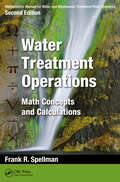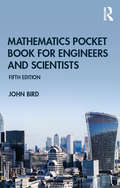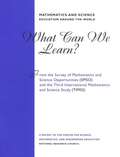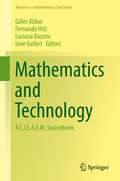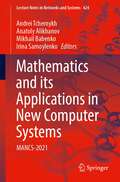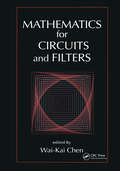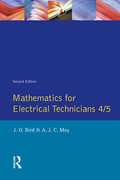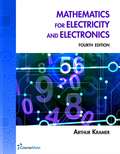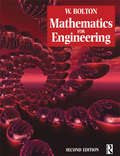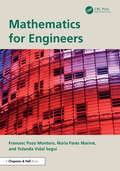- Table View
- List View
Mathematical and Statistical Applications in Food Engineering
by Anoop Singh Surajbhan SevdaWritten by experts from all over the world, the book comprises the latest applications of mathematical and models in food engineering and fermentation. It provides the fundamentals on statistical methods to solve standard problems associated with food engineering and fermentation technology. Combining theory with a practical, hands-on approach, this book covers key aspects of food engineering. Presenting cuttingedge information, the book is an essential reference on the fundamental concepts associated with food engineering.
Mathematical and Statistical Applications in Life Sciences and Engineering
by Mahima Ranjan Adhikari Avishek Adhikari Yogendra Prasad ChaubeyThe book includes articles from eminent international scientists discussing a wide spectrum of topics of current importance in mathematics and statistics and their applications. It presents state-of-the-art material along with a clear and detailed review of the relevant topics and issues concerned. The topics discussed include message transmission, colouring problem, control of stochastic structures and information dynamics, image denoising, life testing and reliability, survival and frailty models, analysis of drought periods, prediction of genomic profiles, competing risks, environmental applications and chronic disease control. It is a valuable resource for researchers and practitioners in the relevant areas of mathematics and statistics.
Mathematical and Statistical Approaches for Anaerobic Digestion Feedstock Optimization (SpringerBriefs in Energy)
by Federico Moretta Giulia BozzanoThis book examines biomass mixture modeling and optimization. The book discusses anaerobic digestion and related fermentative processes and explains their compositional dynamics. Early chapter examine macromolecules, elemental fractions, and their direct influence on methane production. Supported by an extensive data bank of substrates obtained from research, the book points out correlations that enable the estimation of global methane production for diverse biomass mixtures. Furthermore, it provides valuable insights into discerning the optimal composition capable of yielding the utmost methane output.The book integrates cutting-edge machine learning techniques and shows how the programming language Python and Julia can be used for analysis and to optimize processes. It has many graphs, figures, and visuals.
Mathematical and Statistical Methods in Food Science and Technology
by Daniel Granato Gastón AresMathematical and Statistical Approaches in Food Science and Technology offers an accessible guide to applying statistical and mathematical technologies in the food science field whilst also addressing the theoretical foundations. Using clear examples and case-studies by way of practical illustration, the book is more than just a theoretical guide for non-statisticians, and may therefore be used by scientists, students and food industry professionals at different levels and with varying degrees of statistical skill.
Mathematical and Statistical Models and Methods in Reliability
by N. Balakrishnan M. S. Nikulin V. V. RykovThe book is a selection of invited chapters, all of which deal with various aspects of mathematical and statistical models and methods in reliability. Written by renowned experts in the field of reliability, the contributions cover a wide range of applications, reflecting recent developments in areas such as survival analysis, aging, lifetime data analysis, artificial intelligence, medicine, carcinogenesis studies, nuclear power, financial modeling, aircraft engineering, quality control, and transportation. Mathematical and Statistical Models and Methods in Reliability is an excellent reference text for researchers and practitioners in applied probability and statistics, industrial statistics, engineering, medicine, finance, transportation, the oil and gas industry, and artificial intelligence.
Mathematical, Computational Intelligence and Engineering Approaches for Tourism, Agriculture and Healthcare (Lecture Notes in Networks and Systems #214)
by Pankaj Srivastava S. S. Thakur Georgia Irina Oros Ali A. AlJarrah Vichian LaohakosolThis book is a collection of selected papers presented at the 17th FAI International Conference on Engineering, Mathematical and Computational Intelligence (ICEMCI 2019), held at Jabalpur Engineering College, India, from 21–23 December 2019. This book discusses mathematical, computational intelligence and engineering approaches for tourism, agriculture and health care. It is a unique combination of a wide spectrum of topics, such as tourism destination ranking, medical diagnosis-based intelligent systems, drivers for hotel objectives, irrigation systems and more, which are discussed by using fuzzy, statistical and neural network tools. This book will be valuable to faculty members, postgraduate students, research scholars as well as readers from the industrial sector.
Mathematicians Fleeing from Nazi Germany: Individual Fates and Global Impact
by Reinhard Siegmund-SchultzeThe emigration of mathematicians from Europe during the Nazi era signaled an irrevocable and important historical shift for the international mathematics world. Mathematicians Fleeing from Nazi Germany is the first thoroughly documented account of this exodus. In this greatly expanded translation of the 1998 German edition, Reinhard Siegmund-Schultze describes the flight of more than 140 mathematicians, their reasons for leaving, the political and economic issues involved, the reception of these emigrants by various countries, and the emigrants' continuing contributions to mathematics. The influx of these brilliant thinkers to other nations profoundly reconfigured the mathematics world and vaulted the United States into a new leadership role in mathematics research. Based on archival sources that have never been examined before, the book discusses the preeminent emigrant mathematicians of the period, including Emmy Noether, John von Neumann, Hermann Weyl, and many others. The author explores the mechanisms of the expulsion of mathematicians from Germany, the emigrants' acculturation to their new host countries, and the fates of those mathematicians forced to stay behind. The book reveals the alienation and solidarity of the emigrants, and investigates the global development of mathematics as a consequence of their radical migration. An in-depth yet accessible look at mathematics both as a scientific enterprise and human endeavor, Mathematicians Fleeing from Nazi Germany provides a vivid picture of a critical chapter in the history of international science.
Mathematics Applied to Engineering and Management (Mathematical Engineering, Manufacturing, and Management Sciences)
by Mangey Ram and S. B. SinghThis book offers the latest research advances in the field of mathematics applications in engineering sciences and provides a reference with a theoretical and sound background, along with case studies. In recent years, mathematics has had an amazing growth in engineering sciences. It forms the common foundation of all engineering disciplines. This new book provides a comprehensive range of mathematics applied to various fields of engineering for different tasks in fields such as civil engineering, structural engineering, computer science, electrical engineering, among others. It offers articles that develop the applications of mathematics in engineering sciences, conveys the innovative research ideas, offers real-world utility of mathematics, and plays a significant role in the life of academics, practitioners, researchers, and industry leaders. Focuses on the latest research in the field of engineering applications Includes recent findings from various institutions Identifies the gaps in the knowledge of the field and provides the latest approaches Presents international studies and findings in modelling and simulation Offers various mathematical tools, techniques, strategies, and methods across different engineering fields
Mathematics Education and Technology-Rethinking the Terrain
by Celia Hoyles Jean-Baptiste LagrangeMathematics Education and Technology-Rethinking the Terrain revisits the important 1985 ICMI Study on the influence of computers and informatics on mathematics and its teaching. The focus of this book, resulting from the seventeenth Study led by ICMI, is the use of digital technologies in mathematics teaching and learning in countries across the world. Specifically, it focuses on cultural diversity and how this diversity impinges on the use of digital technologies in mathematics teaching and learning. Within this focus, themes such as mathematics and mathematical practices; learning and assessing mathematics with and through digital technologies; teachers and teaching; design of learning environments and curricula; implementation of curricula and classroom practice; access, equity and socio-cultural issues; and connectivity and virtual networks for learning, serve to organize the study and bring it coherence. Providing a state-of-the-art view of the domain with regards to research, innovating practices and technological development, Mathematics Education and Technology-Rethinking the Terrain is of interest to researchers and all those interested in the role that digital technology plays in mathematics education.
Mathematics Education in Brazil: Panorama of Current Research
by Alessandro Jacques Ribeiro Lulu Healy Rute Elizabete Borba Solange Hassan FernandesThis book presents, for the first time in English, the state of the art of Mathematics Education research in Brazil, a country that has the strongest community in this field in Latin America. Edited by leading researchers in the area, the volume provides the international academic community a summary of the scientific production of the thirteen working groups of the Brazilian Society of Mathematics Education (SBEM), the national scientific society that brings together researchers, teachers, students and other professionals of the area. These working groups meet every three years at the International Seminar of Mathematics Education (SIPEM) and cover the following topics: Mathematics Education in the Early Years and Primary Education (Y1-Y5); Mathematics Education in the Middle School (Y6-Y9); Mathematics Education in the High School (Y10-Y12); Mathematics Education at the University level; History of Mathematics, Culture and Mathematics Education; Digital Technologies and Distance Education; Teacher Education; Assessment and Mathematics Education; Cognitive and Linguistic Processes in Mathematics Education; Mathematical Modeling; Philosophy of Mathematics Education, Teaching Probability and Statistics; and Difference, Inclusion and Mathematics Education. Each chapter of the book presents an overview of the production of a working group and they are all preceded by an introduction by professor Ubiratan D’Ambrosio, one of the pioneers of Mathematics Education in Brazil.
Mathematics Manual for Water and Wastewater Treatment Plant Operators: Basic Mathematics for Water and Wastewater Operators
by Frank R. SpellmanTo properly operate a waterworks or wastewater treatment plant and to pass the examination for a waterworks/wastewater operator’s license, it is necessary to know how to perform certain calculations. All operators, at all levels of licensure, need a basic understanding of arithmetic and problem-solving techniques to solve the problems they typically encounter in the workplace. Hailed on its first publication as a masterly account written in an engaging, highly readable, user-friendly style, the fully updated Mathematics Manual for Water and Wastewater Treatment Plant Operators: Basic Mathematics for Water and Wastewater Operators introduces and reviews fundamental concepts critical to qualified operators. It builds a strong foundation based on theoretical math concepts, which it then applies to solving practical problems for both water and wastewater operations. Features: • Provides a strong foundation based on theoretical math concepts, which it then applies to solving practical problems for both water and wastewater operations. • Updated throughout and with several new practical problems added. • Provides illustrative examples for commonly used waterworks and wastewater treatment operations covering unit process operations found in today’s treatment facilities.
Mathematics Manual for Water and Wastewater Treatment Plant Operators: Basic Mathematics for Water and Wastewater Operators
by Frank R. SpellmanTo properly operate a waterworks or wastewater treatment plant and to pass the examination for a waterworks/wastewater operator's license, it is necessary to know how to perform certain calculations. All operators, at all levels of licensure, need a basic understanding of arithmetic and problem-solving techniques to solve the problems they typicall
Mathematics Manual for Water and Wastewater Treatment Plant Operators: Math Concepts and Calculations
by Frank R. SpellmanTo properly operate a waterworks or wastewater treatment plant and to pass the examination for a waterworks/wastewater operator’s license, it is necessary to know how to perform certain calculations. All operators, at all levels of licensure, need a basic understanding of arithmetic and problem-solving techniques to solve the problems they typically encounter in the workplace. Hailed on its first publication as a masterly account written in an engaging, highly readable, user-friendly style, the fully updated Mathematics Manual for Water and Wastewater Treatment Plant Operators: Water Treatment Operations covers all the necessary computations used in water treatment today. It presents math operations that progressively advance to higher, more practical applications, including math operations that operators at the highest level of licensure would be expected to know and perform. Features: • Provides a strong foundation based on theoretical math concepts, which it then applies to solving practical problems for both water and wastewater operations. • Updated throughout and with several new practical problems added. • Provides illustrative examples for commonly used waterworks and wastewater treatment operations covering unit process operations found in today’s treatment facilities.
Mathematics Manual for Water and Wastewater Treatment Plant Operators: Math Concepts and Calculations
by Frank R. SpellmanTo properly operate a waterworks or wastewater treatment plant and to pass the examination for a waterworks/wastewater operator’s license, it is necessary to know how to perform certain calculations. All operators, at all levels of licensure, need a basic understanding of arithmetic and problem-solving techniques to solve the problems they typically encounter in the workplace. Hailed on its first publication as a masterly account written in an engaging, highly readable, user-friendly style, the fully updated Mathematics Manual for Water and Wastewater Treatment Plant Operators: Wastewater Treatment Operations covers all the necessary computations used in wastewater treatment today. It presents math operations that progressively advance to higher, more practical applications, including math operations that operators at the highest level of licensure would be expected to know and perform. Features: • Provides a strong foundation based on theoretical math concepts, which it then applies to solving practical problems for both water and wastewater operations. • Updated throughout and with several new practical problems added. • Provides illustrative examples for commonly used waterworks and wastewater treatment operations covering unit process operations found in today’s treatment facilities.
Mathematics Manual for Water and Wastewater Treatment Plant Operators: Math Concepts and Calculations
by Frank R. SpellmanTo properly operate a waterworks or wastewater treatment plant and to pass the examination for a waterworks/wastewater operator's license, it is necessary to know how to perform certain calculations. All operators, at all levels of licensure, need a basic understanding of arithmetic and problem-solving techniques to solve the problems they typicall
Mathematics Manual for Water and Wastewater Treatment Plant Operators: Math Concepts and Calculations
by Frank R. SpellmanTo properly operate a waterworks or wastewater treatment plant and to pass the examination for a waterworks/wastewater operator's license, it is necessary to know how to perform certain calculations. All operators, at all levels of licensure, need a basic understanding of arithmetic and problem-solving techniques to solve the problems they typicall
Mathematics Pocket Book for Engineers and Scientists (Routledge Pocket Books)
by John BirdThis compendium of essential formulae, definitions, tables and general information provides the mathematical information required by engineering students, technicians, scientists and professionals in day-to-day engineering practice. A practical and versatile reference source, now in its fifth edition, the layout has been changed and streamlined to ensure the information is even more quickly and readily available – making it a handy companion on-site, in the office as well as for academic study. It also acts as a practical revision guide for those undertaking degree courses in engineering and science, and for BTEC Nationals, Higher Nationals and NVQs, where mathematics is an underpinning requirement of the course. All the essentials of engineering mathematics – from algebra, geometry and trigonometry to logic circuits, differential equations and probability – are covered, with clear and succinct explanations and illustrated with over 300 line drawings and 500 worked examples based in real-world application. The emphasis throughout the book is on providing the practical tools needed to solve mathematical problems quickly and efficiently in engineering contexts. John Bird’s presentation of this core material puts all the answers at your fingertips.
Mathematics and Science Education Around the World: What Can We Learn From the Survey of Mathematics and Science Opportunities (SMSO) and the Third International Mathematics and Science Study (TIMSS)?
by "SMSO to TIMSS" Writing CommitteeThe National Academies Press (NAP)--publisher for the National Academies--publishes more than 200 books a year offering the most authoritative views, definitive information, and groundbreaking recommendations on a wide range of topics in science, engineering, and health. Our books are unique in that they are authored by the nation's leading experts in every scientific field.
Mathematics and Technology
by Uwe Gellert Gilles Aldon Fernando Hitt Luciana BazziniThis volume collects most recent work on the role of technology in mathematics education. It offers fresh insight and understanding of the many ways in which technological resources can improve the teaching and learning of mathematics. The first section of the volume focuses on the question how a proposed mathematical task in a technological environment can influence the acquisition of knowledge and what elements are important to retain in the design of mathematical tasks in computing environments. The use of white smart boards, platforms as Moodle, tablets and smartphones have transformed the way we communicate both inside and outside the mathematics classroom. Therefore the second section discussed how to make efficient use of these resources in the classroom and beyond. The third section addresses how technology modifies the way information is transmitted and how mathematical education has to take into account the new ways of learning through connected networks as well as new ways of teaching. The last section is on the training of teachers in the digital era. The editors of this volume have selected papers from the proceedings of the 65th, 66th and 67th CIEAEM conference, and invited the correspondent authors to contribute to this volume by discussing one of the four important topics. The book continues a series of sourcebooks edited by CIEAEM, the Commission Internationale pour l'#65533;tude et l'Am#65533;lioration de l'Enseignement des Math#65533;matiques / International Commission for the Study and Improvement of Mathematics Education.
Mathematics and its Applications in New Computer Systems: MANCS-2021 (Lecture Notes in Networks and Systems #424)
by Andrei Tchernykh Irina Samoylenko Anatoly Alikhanov Mikhail BabenkoThis book is based on the best papers accepted for presentation during the International Conference on Mathematics and its Applications in New Computer Systems (MANCS-2021), Russia.The book includes research materials on modern mathematical problems, solutions in the field of cryptography, data analysis and modular computing, as well as scientific computing. The scope of numerical methods in scientific computing presents original research, including mathematical models and software implementations, related to the following topics: numerical methods in scientific computing; solving optimization problems; methods for approximating functions, etc. The studies in mathematical solutions to cryptography issues are devoted to secret sharing schemes, public key systems, private key systems, n-degree comparisons, modular arithmetic of simple, addition of points of an elliptic curve, Hasse theorem, homomorphic encryption and learning with error, and modifications of the RSA system. Furthermore, issues in data analysis and modular computing include contributions in the field of mathematical statistics, machine learning methods, deep learning, and neural networks. Finally, the book gives insights into the fundamental problems in mathematics education. The book intends for readership specializing in the field of cryptography, information security, parallel computing, computer technology, and mathematical education.
Mathematics for Circuits and Filters
by Wai-Kai ChenEvery engineering professional needs a practical, convenient mathematics resource, without extensive theory and proofs. Mathematics for Circuits and Filters stresses the fundamental theory behind professional applications, making an excellent, flexible resource that enables easy access to the information needed to deal with circuits and filters.The sections feature frequent examples and illustrations, reinforcing the basic theory. The examples also demonstrate applications of the concepts. References at the end of each section are drawn from not only traditional sources, but from relevant, nontraditional ones as well, including software, databases, standards, seminars, and conferences. This leads advanced researchers quickly to the data they may need for more specialized problems.An international panel of experts developed the chapters for practicing engineers, concentrating on the problems that they encounter the most and have the most difficulty with. Mathematics for Circuits and Filters aids in the engineer's understanding and recall of vital mathematical concepts and acts as the engineer's primary resource when looking for solutions to a wide range of problems.
Mathematics for Electrical Technicians: Level 4-5
by John Bird Antony J.C. MayThe definition and solution of engineering problems relies on the ability to represent systems and their behaviour in mathematical terms.Mathematics for Electrical Technicians 4/5 provides a simple and practical guide to the fundamental mathematical skills essential to technicians and engineers. This second edition has been revised and expanded to cover the BTEC Higher - 'Mathematics for Engineers' module for Electrical and Electronic Engineering Higher National Certificates and Diplomas. It will also meet the needs of first and second year undergraduates studying electrical engineering.
Mathematics for Electricity and Electronics 4th Edition
by Arthur D. KramerWith its fresh reader-friendly design, MATHEMATICS FOR ELECTRICITY AND ELECTRONICS, 4E equips learners with a thorough understanding of essential algebra and trigonometry for electricity and electronics technology. Well-illustrated information sharpens the reader's ability to think quantitatively, predict results, and troubleshoot effectively, while problem sets for drill and practice reinforce comprehension. To ensure mastery of the latest ideas and technology, the book thoroughly explains all mathematical concepts, symbols, and formulas required by future technicians and technologists.
Mathematics for Engineering (Mathematics For Engineers Ser.)
by W. Bolton W BoltonMathematics for Engineering has been carefully designed to provide a maths course for a wide ability range, and does not go beyond the requirements of Advanced GNVQ. It is an ideal text for any pre-degree engineering course where students require revision of the basics and plenty of practice work. Bill Bolton introduces the key concepts through examples set firmly in engineering contexts, which students will find relevant and motivating. The second edition has been carefully matched to the Curriculum 2000 Advanced GNVQ units:Applied Mathematics in Engineering (compulsory unit 5)Further Mathematics for Engineering (Edexcel option unit 13)Further Applied Mathematics for Engineering (AQA / City & Guilds option unit 25)A new introductory section on number and mensuration has been added, as well as a new section on series and some further material on applications of differentiation and definite integration.Bill Bolton is a leading author of college texts in engineering and other technical subjects. As well as being a lecturer for many years, he has also been Head of Research, Development and Monitoring at BTEC and acted as a consultant for the Further Education Unit.
Mathematics for Engineers
by Francesc Pozo Montero Núria Parés Mariné Yolanda Vidal SeguíMathematics for Engineers offers a comprehensive treatment of the core mathematical topics required for a modern engineering degree. The book begins with an introduction to the basics of mathematical reasoning and builds up the level of complexity as it progresses. The approach of the book is to build understanding through engagement, with numerous exercises and illuminating examples throughout the text designed to foster a practical understanding of the topics under discussion.Features Replete with examples, exercises, and applications Suitable for engineers but also for other students of the quantitative sciences Written in an engaging and accessible style while preserving absolute rigor.
